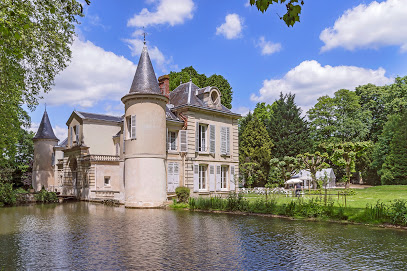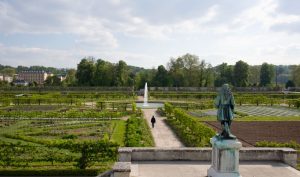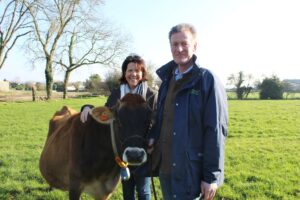By Vincent Obbard of Samarès Manor
CHAUMONTEL is a small town with a Chateau just North of Paris, south of Chantilly, near Luzarches, Seine-et Oise.

This is the place which gave its name to a pear which became famous in the Channel Isles due to its wonderful taste and enormous size. It seems that it was here that they were grown bigger and better than anywhere else.
The pear was discovered by a fruit expert called, Merlet, and included in his book called ‘L’Abrégé des Bons Fruits’ (1675) just at the time that Louis IV was establishing his massive ‘Jardin des Fruits’ at Versailles, on the other side of Paris, to the South West.
One could say ‘Right place, right time.’

Jean-Baptiste de la Quintinie, the Royal gardener, planned the planting of a massive fruit garden, known as le Potager du Roi. This covers a vast area of 25 acres, with a centre piece known as La Grande Carré. La Quintinie had a special liking for pears.
La Quintinie wrote a text book ‘Instructions pour le Jardins Fruitiers et potagers’ explaining his classical ideas of garden design and fruit production. It was a time when growing pear trees as cordons and espaliers became both a means of increasing production as well as popular and fashionable. The book was translated into English by John Evelyn, the famous diarist and author, and published in English as ‘The Compleat Gard’ner’.
Coincidentally, Evelyn corresponded with Philip Dumaresq, Seigneur of Samarès Manor, Jersey. Philip also was an admirer of the French style of classical gardening, having spent time in France during the English Civil war. He and his father had supported the Parliamentarian cause, which had resulted in his banishment from Jersey and the infliction of considerable damage to the Samarès estate by the Royalist supporters at the time, notably, George Carteret of St Ouen.
Despite the enthusiasm for fruit growing in France and even Jersey at this time, the Chaumontel Pear had to wait until another generation before becoming popular. So far I have not succeeded in finding any mention of the Chaumontel pear in any text book until Thomas Hitt who was the head gardener to Lord Manners in 1755, when he describes it in his Treatise on Fruit trees published in 1755. It certainly seems to have been well known in the 18th Century, because it also gets a mention in two other books, one in France (Traité des Arbres Fruitiers by Duhamel du Monceau published 1768) and one in England, coincidentally published the same year, 1768, (The Gardener’s and botanist’s Dictionary by Philip Miller). Duhamel says that the original tree discovered at Chaumontel in 1675 was still thriving in 1768.
The 18th Century was an exciting and unsettled time. The Battle of Jersey, as any schoolboy or girl will tell you, was in 1781. As from the treaty of Versailles in 1783, there was an uneasy truce with France until 1793, when preparations were again being made to defend the Island. During this time smuggling and privateering were still career options for islanders.
Nevertheless, the Chaumontel pear was already famous. A gift of pears was a welcome gift to anyone of class with good taste. In 1760, one Nicolas de Ste Croix, in dire financial straits, asked a friend in Jersey to send a gift of Chaumontel Pears to the Earl of Liverpool, President of the Board of Trade, asking for preferment, sadly, however, to no avail.
By contrast, the 19th Century was a more settled time for change and development. Improved transport links were beginning to make travel to the Channel Isles an attractive proposition for tourism and trade between the islands and the UK could thrive. Only just two years after the Battle of Trafalgar in 1805, John Stead wrote a guide book which gives a glowing account of the Jersey countryside including how the productive soil enabled the inhabitants to grow superior fruit of all kinds:
‘The flavour and size of their peaches, nectarines, apricots, plums, grapes and pears are not excelled in any country in Europe. A species of pears called Chaumontels, which are carefully raised in this island, are unrivalled for their peculiarly delicious flavour; they are often sold here for five pounds a hundred, and many thousand are sent to England every season for presents, and to supply the principal fruit shops in Covent Garden, where they are not unfrequently sold for the extraordinary sum of half a crown each.’
George Lindley in his Guide to the Orchard and Fruit Garden published in 1831, edited by John Lindley FRS, describes the Chaumontel as:
‘large, of an oblong, and somewhat irregular figure, having some slightly obtuse angles, which, more or less, extend from the stalk to the crown; generally about three inches and a half long, and three inches broad…’ However, ‘The Jersey gardeners grow the Chaumontel to a much larger size than what is described above, and fruit from thence I have seen exhibited at the Horticultural Society far exceeding belief.’
A prominent figure in Jersey during the nineteenth century John (later Sir John) Le Couteur FRS, of Belle Vue, St Aubin. In 1833, he was appointed secretary to the newly formed Jersey Agricultural and Horticultural Society. In 1831, he had already been appointed A.D.C. to King William IV. The fact that the Society obtained Royal patronage in 1834 must have been more than partially due to his influence. In 1834, Sir John gave the King a gift of a Belle de Jersey Pear, which he had grown for the Horticultural show in Jersey. It had won first prize and weighed 46 ounces. Another two pears which he had sent, the King had declared to be the best he had ever eaten. The largest Chaumontel ever recorded was presented to Queen Victoria in 1849. It weighed an astonishing 38 ounces, or over a kilo. Even allowing for Jersey weights which were 1⅟₂ ounces per pound heavier than English weights, the competition for the heaviest pears is impressive.
Sir John was a frequent correspondent with the London Horticultural Society. In 1826, a paper was read to the Society by John Lindley (later FRS) about pears received from Captain Le Couteur in Jersey and from a Jersey nurseryman, Peter Langelier. As it happens the paper was about other newly tried Pears, some of which subsequently became famous and still exist to this day. The Chaumontel was already well known by then, no doubt at least in part due to the efforts of men like Le Couteur having already sent samples for trial and identification to London.
The Chroniques de Jersey report of the RJA&HS show in October 1857 demonstrates how popular and successful the Chaumontel pear had become by that date. The first prize was awarded to a Mr Bernier who exhibited 50 Chaumontel pears weighing in total over 50lbs in weight. The second prize went to Mr Treeve for another 50 Chaumontel pears weighing 45⅟₂ lbs.
The fame of the Chaumontel was not confined to the Island and they were regularly shown as well as exported to England, where they obtained high prices.
The fact that Chaumontel pears grew better in Jersey was well known in France too. André Le Roy, who was a nurseryman in Angers, gives a detailed description of the Chaumontel in his book, Dictionnaire de Pomologie, published in 1867. He says that he had heard that the best of these pears are harvested in Jersey, but growers there would obtain their young stock from nurseries in Angers.
The Gardener’s Chronicle of 19 October 1878 refers to a report from Mr C. B Saunders, the Jersey nurseryman, which states that a sample weighing 21 ounces was exhibited at the Royal Jersey show.
“No Apricot, Nectarine, Peach, or Plum is of such delicious flavour as this kind of Pear, with the additional qualification of ripening about Christmas time, when these other fruits are unobtainable, of first rate quality.”
Saunders Nursery, near Granville, Five Oaks, was a tourist attraction in itself. In 1846, Le Couteur had pointed out the nursery to Queen Victoria as he gave the Queen a guided tour of the Island during her visit to the Island that year.
Can this be true?
There is a report in The Gardener’s Chronicle of 1887 that a Mr A. F. Barron had visited Jersey and seen there:
‘..a plantation of 25,000 Chaumontel trees, growing in the best form, about six feet in height, but all pruned down to flat heads. They are trained in this way to secure the crop as much as possible against the winds which prevail in the island.’ An impressive sight it must have been!
So what happened to the wonderful reputation enjoyed by the Chaumontel Pear, which is nowadays unheard of?
There are maybe two reasons. First, the popularity of pears as winter fruit has declined, now that so many other fruits can be grown and transported around the world.

Secondly, since other pear varieties became popular, for instance, the Conference, first exhibited in 1885, and the Doyenné de Comice, first listed in the UK in 1853, the long list of pears once grown to perfection in different parts of Europe, America and South Africa has gradually disappeared. Joan Morgan in The Book of Pears says that Chaumontel pears were still known in the 1930’s, but few survive today. Brian Phillipps, who collected all the Jersey apple varieties in the 1980’s also found surviving Chaumontel trees in Jersey. There is now a good specimen grafted by him growing on a south facing wall at the Elms, St Mary.
The Chaumontel needs good rich soil and plenty of sunshine to grow to its perfection. It has to be understood that the pear is late to mature. If picked in October it must be kept in a dry cool place until Christmas when it ripens and can be enjoyed at its best.




